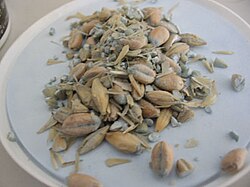 | |
| Names | |
|---|---|
| IUPAC name (RS)-2-Hydroxy-3-(1,2,3,4-tetrahydronaphthalen-1-yl)-4H-chromen-4-one | |
| Identifiers | |
3D model (JSmol) | |
| ChemSpider | |
| ECHA InfoCard | 100.024.931 |
| KEGG | |
PubChem CID | |
| UNII | |
CompTox Dashboard (EPA) | |
| |
| |
| Properties | |
| C19H16O3 | |
| Molar mass | 292.334 g·mol−1 |
| Hazards | |
| GHS labelling: | |
   [1] [1] | |
| Danger [1] | |
| H300, H311, H330, H360D, H372, H410 [1] | |
| P201, P202, P260, P264, P270, P271, P273, P280, P281, P284, P301+P310, P302+P352, P304+P340, P308+P313, P310, P312, P314, P320, P321, P322, P330, P361, P363, P391, P403+P233, P405, P501 [1] | |
Except where otherwise noted, data are given for materials in their standard state (at 25 °C [77 °F], 100 kPa). | |
Coumatetralyl is an anticoagulant of the 4-hydroxycoumarin vitamin K antagonist type used as a rodenticide. [2]
